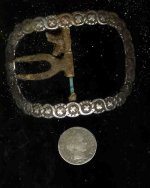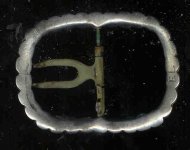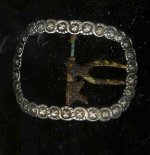Green1
Silver Member
got this today at a spot that goes back to the mid 1600's.. it has one of the forked things broke off, (should be 3) can anyone date this and maybe an approximate worth ?? i don't sell, i'm just curious...
thanx a lot.. rick...
thanx a lot.. rick...







 thanx guys !!!!!! crusader, how would i get an approximate worth, any ideas ??
thanx guys !!!!!! crusader, how would i get an approximate worth, any ideas ?? , since it was found in New England area which had a few silversmiths of their own, hopefully someone will give a more definitive answer. It is a beautiful shoe buckle.............
, since it was found in New England area which had a few silversmiths of their own, hopefully someone will give a more definitive answer. It is a beautiful shoe buckle.............

